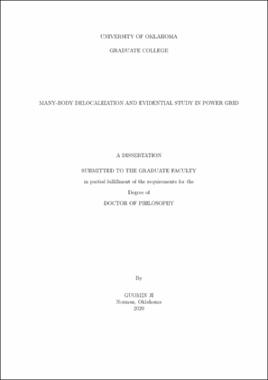| dc.description.abstract | Complex energy flow dynamics following an untoward event has a direct impact on the
responses of the protective and stabilization control systems of the power grid, in defending
the power grid against from large-scale cascading failures or network fragmentation.
In this dissertation, a non-classic view and an analytical framework on electro-mechanical
dynamics are proposed, which is different from the electric circuit-based ones built up
classic physics.
Inspired from some recent advances in port-Hamiltonian formulism in control systems
and random work interpretation of energy flows in electric circuit, a hypothetical but
well-grounded unitary view on power grid is postulated, which leads to the new concept
of many-body delocalization. The power grid with n ports of synchronized components
can be transformed into a unitary electromagnetic field, which can be mathematically
described by a complete graph that couples the active and passive resources and
boundaries. Thus, the energy flow becomes the manifestation of an underlying unitary
electromagnetic field.
A quantum number-based analytical framework is built based on several principles related
to the unitary field view, such as Hermitian symmetry, Heisenberg uncertainty
principles and general relativistic effect. With the intrinsic properties of the quantum
number-based model, a new network property is developed, namely z-direction radical
distance. This is a new concept about the projection of angular quantum number
and the unit reference potential. This novel radical distance concept describes the fundamental
connection between the energy flow in a complex network and its structure: it
stands for the fraction of system energy surging at various spots as the result of l-motions
along the z-direction, later found very useful for understanding the energy flow in power
grid. An evidential experiment is carried out using a real world power grid model of
electro-mechanical stability. With mathematical tools from tensor analysis of network,
the estimation of distribution of network energy flow in the power grid is derived. By comparing the radical distance based estimation of electromagnetic waves in the power
grid to the one calculated with the complete dynamic system model of the power grid, a
remarkable consistency is observed. This dissertation presents a unique perspective for
complex network analysis, which is drastically different from the current “small-world”
one. Based on its analytical root and the evidential experiments, we discover that radical
distance is a metric that penetrates the boundary between the microscopic quantum
world and real-world macroscopic power and energy systems. Such a discovery suggests
the possibility of the coupling of active resources of power grid could be of the entangled
particles type, authoring the usage of quantum effects in explaining and dealing with
the states at a macroscopic scale, at least from a modeling/analytical perspective. | en_US |

